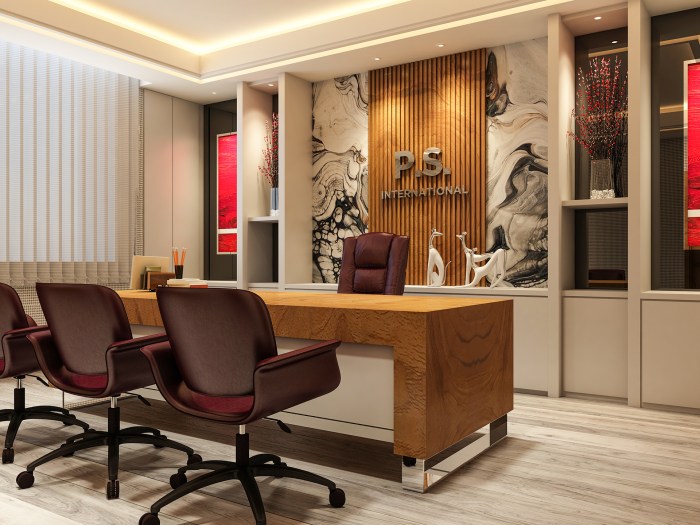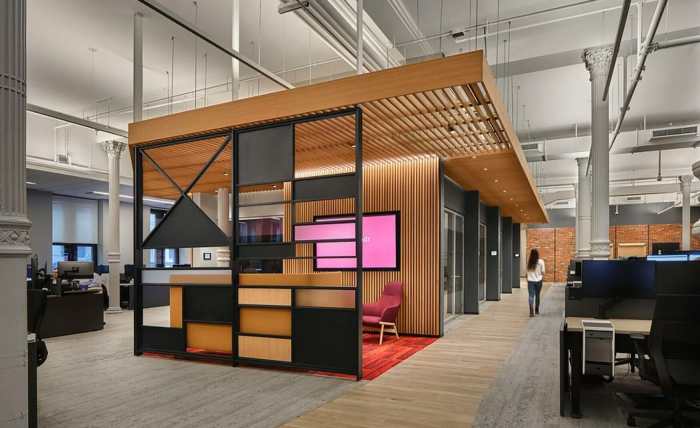Optimizing Workspaces: Office Interior Design Essentials

Embark on a journey into the realm of office interior design, where the layout and aesthetics of a workspace play a pivotal role in shaping employee productivity and well-being. This article delves into the key elements, trends, and tips to create a harmonious and inspiring office environment.
As we explore the impact of office design on employee performance and delve into the latest trends transforming workspaces, you'll uncover the secrets to crafting a productive and engaging workplace.
Importance of Office Interior Design

Office interior design plays a crucial role in the overall productivity and well-being of employees. A well-designed office space can have a significant impact on employee morale, motivation, and overall satisfaction.
Impact on Employee Productivity
- Effective space planning and layout can optimize workflow and minimize distractions, leading to increased focus and efficiency.
- Access to natural light and greenery can boost mood and energy levels, enhancing productivity throughout the workday.
- Comfortable furniture and ergonomic design elements can reduce physical strain and fatigue, allowing employees to work more comfortably for longer periods.
Influence on Employee Morale and Well-being
- Thoughtfully designed breakout areas and collaborative spaces can encourage communication, creativity, and a sense of community among employees.
- Incorporating elements of biophilic design, such as plants and natural materials, can reduce stress and improve overall well-being.
- Personalized workstations and flexible seating options can empower employees to work in ways that suit their individual preferences and work styles.
Examples of Successful Office Interior Design Concepts
- Google's offices feature vibrant colors, playful design elements, and various themed spaces to inspire creativity and innovation.
- Airbnb's headquarters incorporate unique meeting rooms designed to resemble listings on their platform, fostering a sense of connection to their brand and values.
- Microsoft's workplace design focuses on creating a balance between open collaboration areas and private workspaces to accommodate different work styles and preferences.
Elements of Effective Office Interior Design
Effective office interior design involves several key elements that contribute to creating a productive and comfortable workspace for employees. These elements include lighting, furniture layout, color schemes, ergonomics, green spaces, natural elements, and technology integration.
Lighting
Proper lighting is crucial in office interior design as it can significantly impact the mood, productivity, and well-being of employees. Natural light is preferred whenever possible as it helps reduce eye strain, boost mood, and increase energy levels. Additionally, incorporating adjustable artificial lighting allows employees to customize their lighting based on their tasks and preferences.
Furniture Layout
The layout of furniture in an office space plays a vital role in promoting collaboration, communication, and productivity among employees. Open layouts with flexible furniture arrangements can encourage interaction while providing individual workspaces for focused tasks. Ergonomic furniture is also essential to support the health and comfort of employees during long work hours.
Color Schemes
Color psychology is a key consideration in office interior design. Different colors can evoke various emotions and affect concentration levels. Choosing a color scheme that aligns with the company's brand identity while promoting a positive work environment is essential. Soft blues and greens can create a calming effect, while vibrant colors like red or yellow can stimulate creativity and energy.
Ergonomics
Ergonomics focuses on designing workspaces and furniture to fit the needs of employees, reducing the risk of musculoskeletal disorders and increasing overall comfort. Adjustable desks, supportive chairs, and proper monitor positioning are essential aspects of ergonomic office design that can enhance productivity and employee well-being.
Green Spaces and Natural Elements
Incorporating green spaces, plants, and natural elements in office interior design can have numerous benefits, including improved air quality, reduced stress levels, and increased creativity
Technology Integration
Modern office design often involves seamless integration of technology to support communication, collaboration, and efficiency. Smart technology solutions, such as automated lighting systems, digital whiteboards, and integrated communication platforms, can streamline work processes and enhance connectivity among employees.
Trends in Office Interior Design

Office interior design trends are constantly evolving to meet the changing needs of businesses and employees. These trends not only focus on aesthetics but also on functionality and employee well-being.
Open Workspaces and Flexible Layouts
One of the current trends in office design is the shift towards open workspaces and flexible layouts. This design concept promotes collaboration, communication, and creativity among employees. Open workspaces often feature shared desks, communal areas, and flexible furniture arrangements to accommodate different work styles and preferences.
Sustainable and Eco-Friendly Design Practices
Another significant trend in office interior design is the increasing emphasis on sustainable and eco-friendly practices. Companies are incorporating elements such as energy-efficient lighting, recycled materials, and indoor plants to create a healthier and more environmentally friendly workspace. Green design not only reduces the carbon footprint of the office but also improves air quality and overall well-being of employees.
Impact of COVID-19 Pandemic
The COVID-19 pandemic has greatly influenced office design trends, with a heightened focus on health and safety measures. Companies are now implementing social distancing protocols, installing barriers, and enhancing cleaning procedures to ensure a safe work environment for employees. Additionally, the pandemic has accelerated the adoption of remote work practices, leading to a reevaluation of office layouts to accommodate a more flexible and hybrid work model.
Creating a Productive Work Environment

Creating a workspace that promotes productivity is crucial for the success of any business. A well-designed office can enhance creativity, collaboration, and overall employee satisfaction. Here are some tips on how to design an office space that fosters these elements:
Balance between Aesthetics and Functionality
Finding the perfect balance between aesthetics and functionality is key in office interior design. While it's important for the space to look visually appealing, it should also be practical and conducive to work. Choose furniture, lighting, and decor that not only look good but also serve a purpose and enhance productivity.
Creating Different Zones within the Office
It's essential to create different zones within the office for various tasks. Designate areas for focused work, collaboration, meetings, and relaxation. Each zone should be tailored to the specific needs of the employees and the tasks they perform. This helps in minimizing distractions and maximizing productivity.
Fostering Creativity and Collaboration
To encourage creativity and collaboration, consider incorporating open workspaces, breakout areas, and collaborative zones in the office design. These spaces can inspire employees to brainstorm, share ideas, and work together towards common goals. Additionally, adding elements like whiteboards, comfortable seating, and natural light can further enhance creativity and collaboration in the workplace.
Closing Summary
In conclusion, office interior design is not just about aesthetics but also about functionality and creating a conducive environment for creativity and collaboration. By staying abreast of trends and implementing effective design elements, businesses can cultivate a workspace that enhances both employee satisfaction and overall productivity.
FAQ Resource
How does office interior design impact employee productivity?
Office interior design influences productivity by creating a workspace that is comfortable, inspiring, and conducive to focus and creativity.
What are some key elements to consider in office interior design?
Key elements include lighting, furniture layout, color schemes, ergonomics, green spaces, and technology integration.
What are some current trends in office interior design?
Current trends include open workspaces, flexible layouts, sustainable and eco-friendly practices, and the integration of natural elements.

